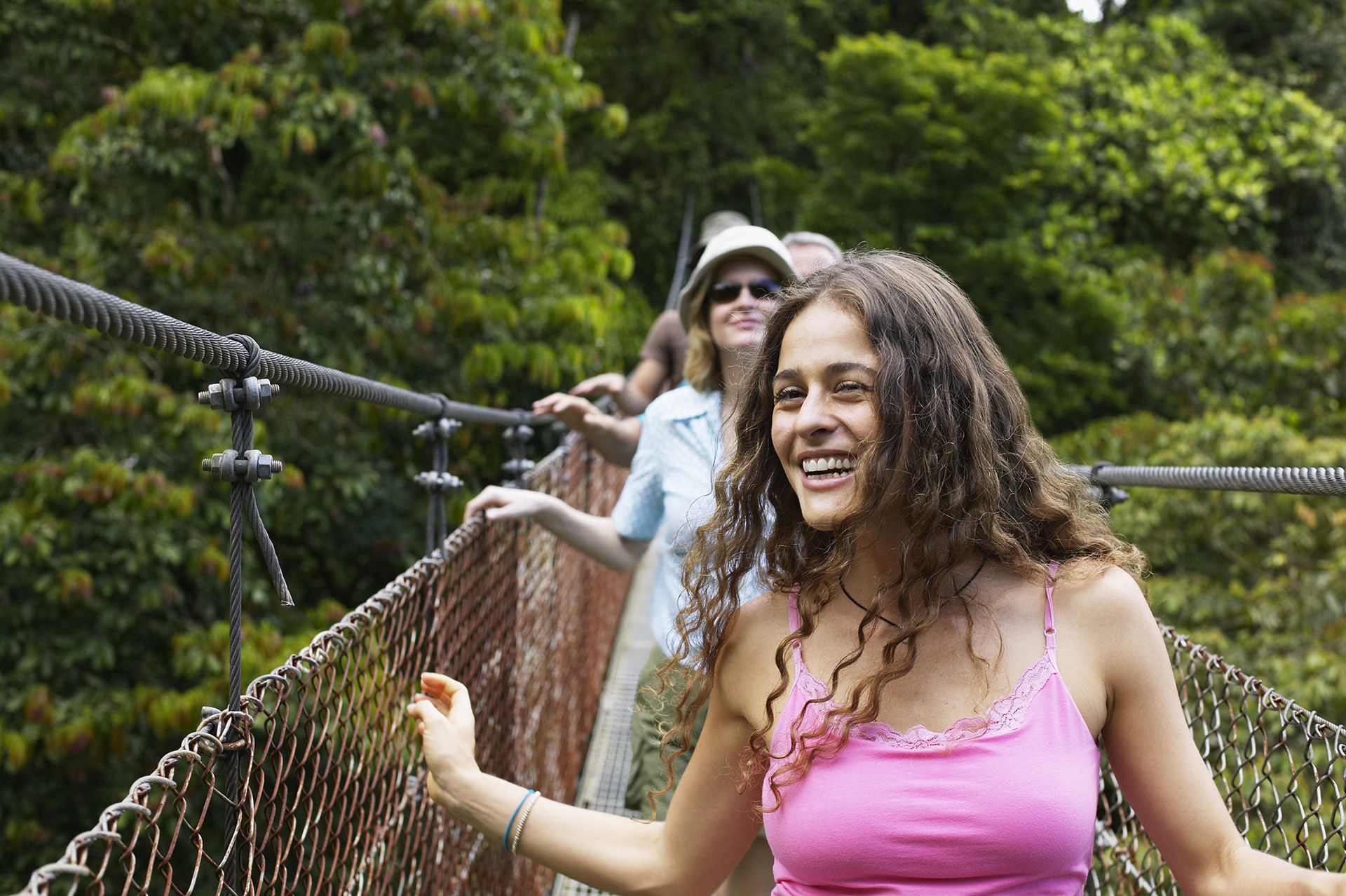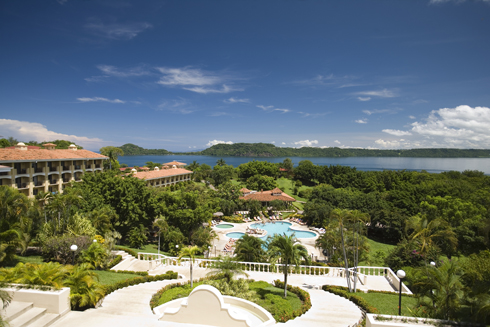
Jungle Walks, Hillside Rambles and Peak Experiences
Lace up your walking shoes and get started, because there is a lot of ground to cover in Costa Rica. Start off with a relaxing stroll to a swimming hole fed by a cascading waterfall. Add more miles with a loop through a rainforest filled with bird songs and the chatter of monkeys. Gain elevation with an ascent to the peak of a dormant volcano or a climb into a cloud forest where more than 100 species of orchids thrive. There are routes for all interests and ability levels, and many hikes can be enjoyed as day trips from beachside resorts or mountain lodges.
Highlights
- Best for: All travellers from budget to luxury with a love of nature and adventure
- Best season to visit: Year Round, drier November - May
- Weather: There is minimal seasonal variation in air temperatures, with highs reaching near 90 and lows touching 70 at night. The wet season runs from May through November, drier months from December to April bring lower humidity
Things to Do
- Cultural Activities
- Diving
- Offroading
- Paddle Sports
- Spa and Wellness
- Ziplining
Costa Rica Information
Hiking in Costa Rica Overview
More than half of Costa Rica is covered in forests, much of which lies within 26 national parks and 160 additional protected areas. Five major mountain ranges rise from the coastal plains on the Caribbean and Pacific coasts, creating 12 distinct climate zones. Hiking trails give access to the country's full extent of ecological diversity, with routes ranging from easy mile-long walks to multi-day treks to mountain summits and remote valleys.
Hiking in Costa Rica Tips
Dress for the elevation. While coastal areas often see temperatures in the 90s, mountain regions can be 20 degrees cooler, and on the way to the summit of tall peaks, hikers may see the mercury drop into the lower 60s, which can feel chillier than expected when accompanied by higher humidity, as is the case in cloud forests.
Best Places for Hiking in Costa Rica
Trails in Arenal National Park lead through lava beds, open savannas and rain forests, delivering the closest safe view of an active volcano. A hike into Rincon de la Vieja passes smoking fumaroles, hot mud pools, and eerie steam holes. Other routes enter ancient forests on the way to naturally heated pools and cool waterfalls.
What to Pack for Hiking in Costa Rica
Hiking shoes that breathe, and have enough tread to hold on muddy inclines. Light to mid-weight moisture-wicking clothing and a spare pair of socks. Swimsuit and a towel if there are waterfalls or hot springs on the route. A light, water-resistant jacket for higher altitude hikes. Hat and sunglasses. Remember a daypack for water, snacks and sundries.
Resorts

Costa Rica
Bosque del Mar Hotel
PLAYA HERMOSA Unique beach front high-end boutique eco concept located in Hermosa Bay, Guanacaste. Surrounded by beautiful beachfront gardens with frequent visits by local monkeys and iguanas. Playa Hermosa Bay is a great and peaceful location for beach lovers, not crowded and offers a gorgeous view of Pacific Ocean. Close to Local diving, Catalina Island and Bat Island and lots of topside activities.
Book on-line or Contact Caradonna Adventures at 800-330-6611 or email us sales@caradonna.com.
See Packages & Learn More

Costa Rica
Occidental Papagayo
PAPAGAYO 10 DIVES & 1-ZIP LINE ADVENTURE 7 night's package includes accommodations, 5 days of 2-tank boat dives, breakfast, 1-Canopy Treetop Zip Line adventure, lunch, and dinner daily, snacks and beverages including alcohol, roundtrip airport transfers, free WiFi, hotel tax and service charges. Adults Only.
Book on-line or Contact Caradonna Adventures at 800-330-6611 or email us sales@caradonna.com.
See Packages & Learn More
Passport and/or Visa Requirements
A valid passport is required for entry that must be valid for length of stay. No visa is required for stays less than 90 days. The passport must have at least one blank page for the Costa Rica entry stamp. There is a departure tax of approximately $29 U.S. which should be included in your international ticket. Check the entry/exit requirements here.
Immunizations
There are no immunizations required for entry into Costa Rica, although you should check with your doctor and with the Centers for Disease Control and Prevention for other recommendations.
Culture and Customs
Costa Rica is known as the safest and most prosperous country in Central America. It is home to a large community of North American ex-pats, but also retains its distinctly Latin culture, which includes a relaxed attitude to schedules that is known as “Tico time.” Laid back is not the same as uncaring, however, and Costa Ricans are known for taking pride in their appearances and their work. A well-developed road system connects major destinations, but much of the country's central highlands remain wild and protected within national parks. Within a day's drive of beach resorts at Guanacaste lie the slopes of Arenal Volcano, the Monteverde Cloud Forest and Palo Verde National Park. Costa Rica is the eco-adventure capital of the Caribbean. Surfers come from around the world to ride famous breaks from Witch's Rock to Pavones. Coastal lodges are filled with fishermen seeking light tackle challenges with roosterfish or tug of war with a marlin. Forests draw birders, hikers and naturalists, and there are more than a dozen rivers offering whitewater rafting thrills. More relaxing experiences await at hot springs, where spa treatments and soaks in mineral-rich volcanic water provide a soothing end to an active day.
Electricity, Phone and Internet Access
The standard in Costa Rica is the same as in the United States: 110 volts AC (60 cycles). Some electric outlets only have 2 prong sockets, so an adapter may be needed for 3 prong plugs.
Costa Rica has an excellent phone system, and the country code for dialing is 506. Check with your cell phone provider for international data and voice plans and costs.
Many resorts and restaurants offer WiFi.
Water Quality
Although the water in Costa Rica is generally safe to drink, water quality varies in some cities. It would be best to use bottled water and avoid ice.
Language & Currency
Spanish is the official language of Costa Rica, but English is widely spoken. The Costa Rican currency is called the “colon”. Check the current exchange rate here. Many businesses will accept U.S. Dollars and major credit cards are widely accepted.
Time
Costa Rica is on Central Standard Time, 6 hours behind Greenwich Mean Time (-6 GMT). Costa Rica does not use daylight saving time, so the time difference is an additional hour April through October.
Location, Size and Population
Costa Rica is located in Central America, bordering both the Caribbean Sea and the North Pacific Ocean, between Nicaragua (to the north) and Panama (to the south). Costa Rica encompasses a total of 19,700 square miles (51,100 square kilometers).
The population of Costa Rica is 4.9 Million (2015) with approximately 350,000 living in the province of Guanacaste.